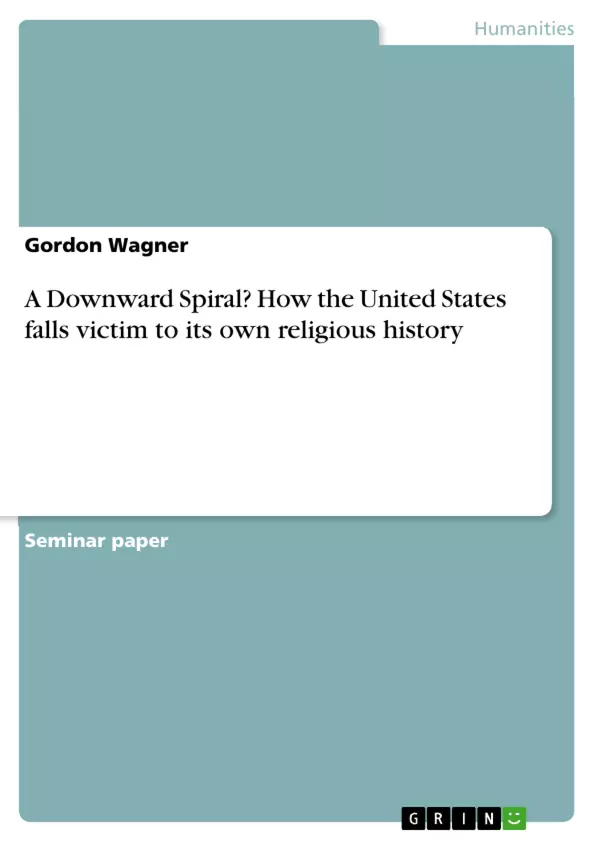Das vorliegende Paper beschäftigt sich mit der Ursache der im Vergleich zu anderen westlichen Staaten auffallend hohen Religiösität in den Vereinigten Staaten von Amerika (U.S.A.), dem wahrscheinlich mächtigsten Nationalstaat der Erde. Neben der besonderen Geschichte als Immigrationsland wird dabei insbesondere die Rolle von Religionen und Kirchen als identitätsstiftende Gemeinschaften herausgestellt; im Anschluss werden die U.S.A. religionstechnisch mit drei europäischen Staaten (Frankreich, Deutschland und die Türkei) verglichen, um auf vorhandene Gemeinsamkeiten und zum Teil deutliche Unterschiede hinzuweisen. Der Fokus der Arbeit liegt hierbei auf einer Beschreibung der (teilweise äußerst negativen) Auswirkungen einer starken religiösen Sphäre auf die Gesellschaft (anhand der Beispiele Bildung/Erziehung, Wissenschaft, Politik und Ethik) sowie möglichen Lösungsvorschlägen und Zukunftsaussichten.
Inhaltsverzeichnis (Table of Contents)
- Abstract
- 1 Introduction
- 2 History and status quo of religion in the United States
- 3 Different approaches to religion in selected European countries
- 3.1 France
- 3.2 Germany
- 3.3 Turkey
- 4 Consequences of a strong religious sphere
- 4.1 Education
- 4.3 Science
- 4.4 Politics
- 4.5 Ethics
- 5 Conclusion: Possible solutions and Future prospects
Zielsetzung und Themenschwerpunkte (Objectives and Key Themes)
This paper examines the reasons behind the high level of religiosity in the United States compared to other Western nations, particularly its role as an immigrant nation and the role of religion and churches in forming identity. The U.S. is then compared to three European countries (France, Germany, and Turkey) to highlight similarities and differences in their religious landscapes. The paper focuses on the impact of a strong religious sphere on society, particularly in the areas of education, science, politics, and ethics, as well as potential solutions and future prospects.
- Religious influence on American identity and society
- Comparison of religious approaches in the U.S. and Europe
- Consequences of strong religious influence on education, science, politics, and ethics
- Potential solutions and future prospects for the role of religion in the U.S.
- The question of a "downward spiral" in relation to religion in the United States
Zusammenfassung der Kapitel (Chapter Summaries)
- Chapter 1: Introduction This chapter introduces the paper's topic, highlighting the high level of religiosity in the United States compared to other developed nations. It presents data on American religious beliefs and practices and compares them to those in European countries, raising questions about the factors contributing to this disparity and its impact on various aspects of society.
- Chapter 2: History and status quo of religion in the United States This chapter explores the historical development of religion in the United States, starting with the arrival of European settlers and their religious motivations. It examines the interplay of church and state in the early colonial period, the transition to a separation of church and state, and the impact of the Establishment Clause on religious freedom and the overall social landscape.
- Chapter 3: Different approaches to religion in selected European countries This chapter examines the religious landscapes of three European countries: France, Germany, and Turkey. It compares their historical experiences and current practices to those of the United States, highlighting similarities and differences in the roles of religion in society and the impact of various approaches on education, science, politics, and ethics.
- Chapter 4: Consequences of a strong religious sphere This chapter delves into the consequences of a strong religious sphere in the United States, focusing on its impact on education, science, politics, and ethics. It analyzes how these spheres are influenced by religious values and beliefs, exploring both positive and negative effects and potential challenges.
Schlüsselwörter (Keywords)
This paper focuses on religion in the United States and its impact on various aspects of society. Key terms include religious history, religious influence, secularism, education, science, politics, ethics, social consequences, and the separation of church and state. The paper aims to understand the unique features of religious landscape in the U.S. and its implications for the future.
- Quote paper
- Gordon Wagner (Author), 2014, A Downward Spiral? How the United States falls victim to its own religious history, Munich, GRIN Verlag, https://www.grin.com/document/279761



